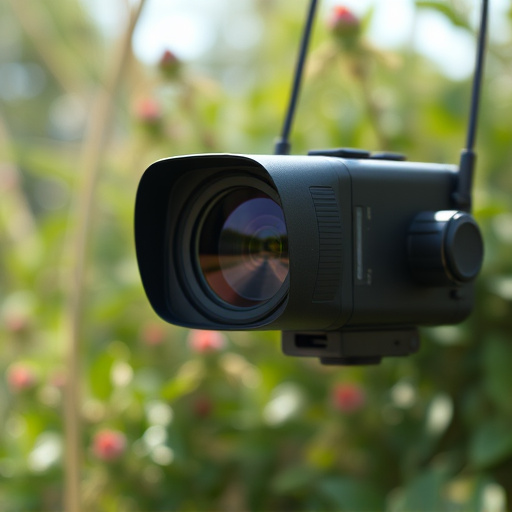Undetectable wireless security cameras, disguised as everyday objects like plants or light bulbs, transmit video signals wirelessly. Their advanced features make them nearly impossible to identify without specialized tools. Smartphone apps leveraging machine learning and image processing technologies now aid in their detection. Countermeasures include UV lights, thermal imaging, and app-based signal scanning. The proliferation of these cameras sparks debates over privacy and surveillance, highlighting the need for clear legal boundaries. While mobile apps offer security, their effectiveness and ethical implications vary globally due to differing data protection regulations.
Undetectable wireless security cameras have become a growing concern, as their tiny size and advanced technology make them nearly invisible to the naked eye. This article explores how smartphone technology is revolutionizing lens detection, offering practical methods to identify hidden cameras. We delve into legal and ethical considerations surrounding spy camera lens detection apps, providing insights for both consumers and professionals seeking to protect privacy in today’s digital era.
- Understanding Undetectable Wireless Security Cameras
- The Role of Smartphone Technology in Lens Detection
- Effective Methods to Identify Hidden Cameras
- Legal and Ethical Considerations for Spy Camera Lens Detection Apps
Understanding Undetectable Wireless Security Cameras
Undetectable wireless security cameras have evolved into a significant concern in today’s digital age, where privacy and surveillance are tightly intertwined. These tiny devices, often hidden within everyday objects like plants, light bulbs, or even wall sockets, transmit video signals wirelessly to a receiver or a connected smartphone app. Their sophistication lies in their ability to operate without drawing attention, making them particularly appealing for clandestine observation.
While many modern smartphones have image processing capabilities that can detect anomalies, such as irregular lens shapes or patterns, undetectable wireless security cameras often employ advanced techniques to bypass these checks. They may use specialized lenses designed to mimic ordinary objects, employ encrypted communication protocols, or have built-in measures to avoid detection by heat signatures or electronic signals. As a result, it has become increasingly challenging for casual users to identify these hidden cameras without specialized knowledge or tools.
The Role of Smartphone Technology in Lens Detection
Smartphone technology has revolutionized the way we detect hidden threats, including undetectable wireless security cameras. With advancements in camera and image processing capabilities, modern smartphones are now equipped to identify and expose spy cameras that were once almost impossible to detect. Apps designed for this purpose use advanced algorithms to analyze video feeds and detect anomalies, such as unusual light patterns or hidden lenses, which are common indicators of surveillance equipment.
These apps leverage the high-resolution cameras and powerful processing units found in today’s smartphones to scan environments in real-time. By utilizing machine learning techniques, these devices can learn to recognize typical scenes and objects, making it easier to identify suspicious elements that might suggest the presence of undetectable wireless security cameras. This technology empowers individuals to take privacy and security into their own hands, ensuring a more vigilant and safe digital environment.
Effective Methods to Identify Hidden Cameras
Hidden cameras, especially undetectable wireless security cameras, have become a growing concern in today’s digital age. While they offer convenience and surveillance, their misuse can infringe on privacy. Fortunately, several effective methods exist to identify these hidden devices. One of the most common techniques is using specialized smartphone apps designed for camera detection. These apps employ advanced sensors and AI algorithms to scan for infrared or visible light signals that might indicate a hidden camera’s presence.
Another robust approach involves physical inspections with equipment like UV lights, which can reveal reflective tape commonly used in covert cameras. Additionally, professionals often utilize thermal imaging technology, as heat signatures from electronic components can be detected even when the camera itself is not visible. By combining these methods, individuals and organizations can significantly reduce the risk of being monitored by undetectable wireless security cameras, enhancing privacy and data protection.
Legal and Ethical Considerations for Spy Camera Lens Detection Apps
The rise of undetectable wireless security cameras has sparked a debate around privacy and surveillance, prompting discussions on legal and ethical boundaries. As technology advances, small, covert cameras can be hidden in everyday objects, raising concerns about potential abuse. Mobile applications that claim to detect these spy cameras have gained popularity, but they also raise ethical questions.
Using such apps on public property or without explicit consent may infringe upon privacy rights. The effectiveness of these tools is debatable, as some undetectable cameras might bypass the detection methods. Moreover, the legality of app-based camera detection varies by region, with different countries and states having distinct data protection laws. Users should be mindful of their legal standing and ethical implications when considering such technology.
Undetectable wireless security cameras, once a subtle threat, are now vulnerable to smartphone technology. By leveraging advanced sensors and image analysis apps, users can proactively identify hidden lenses, ensuring privacy in today’s digital age. While legal and ethical considerations must be addressed, the availability of these tools empowers individuals to safeguard their personal spaces effectively.
